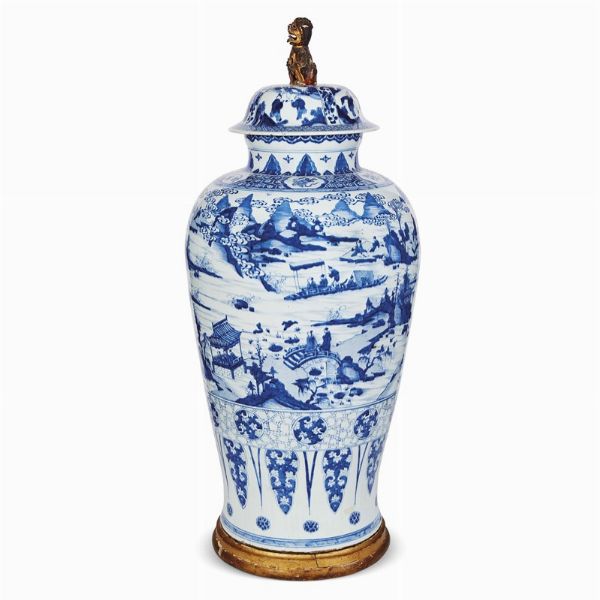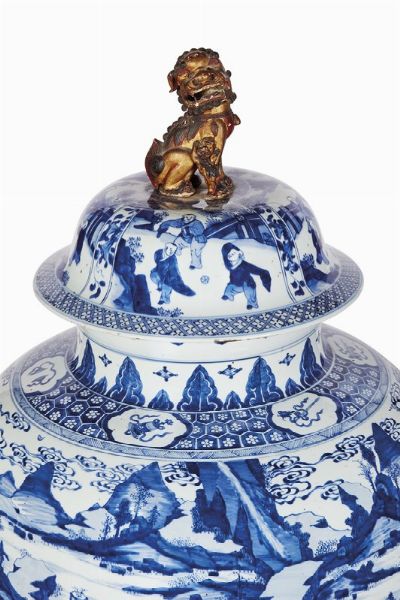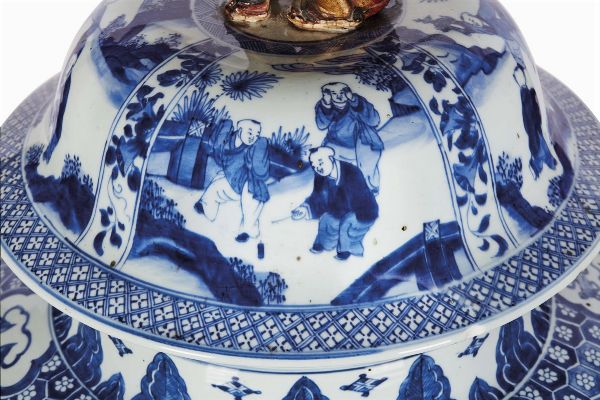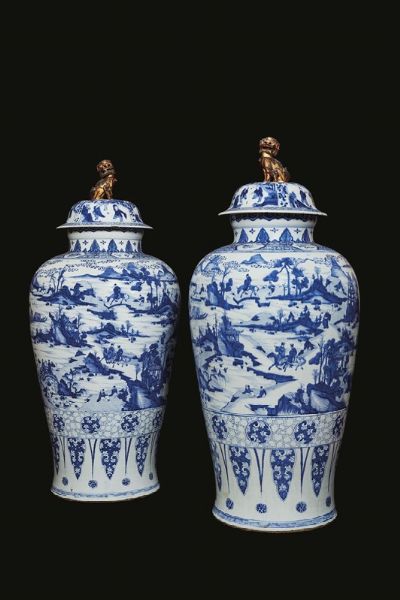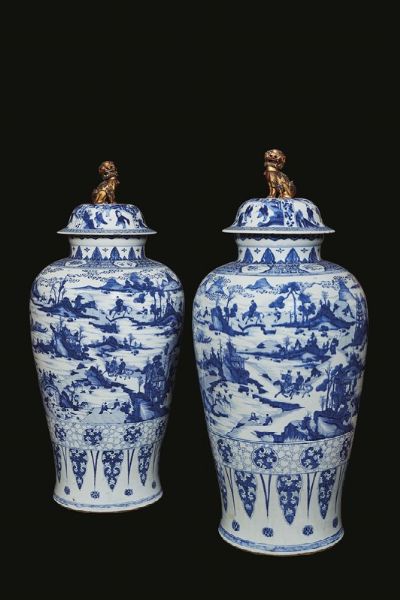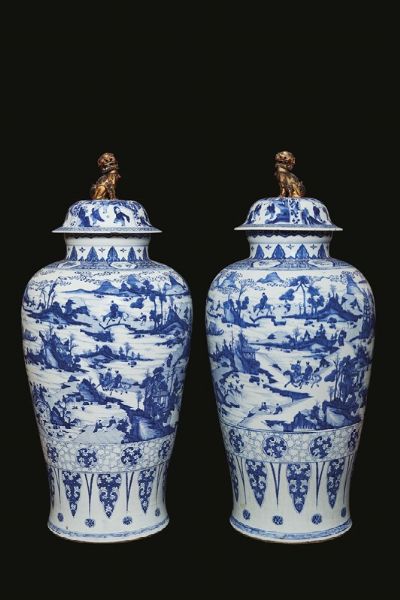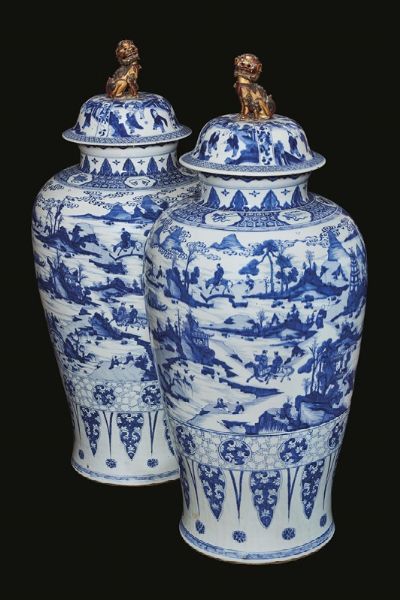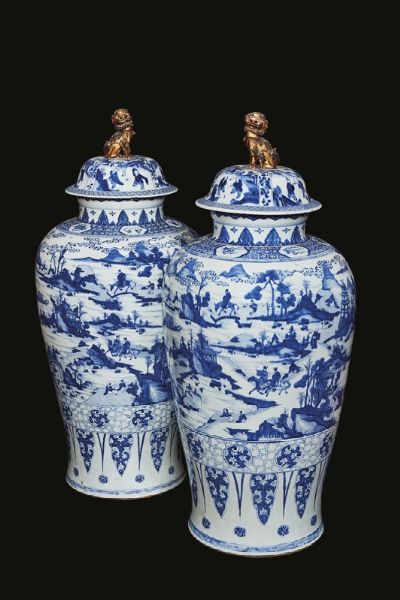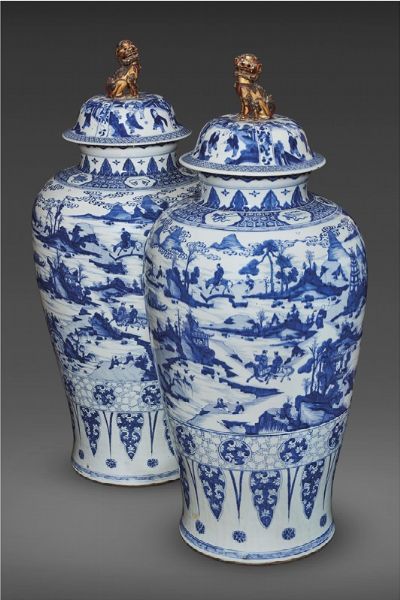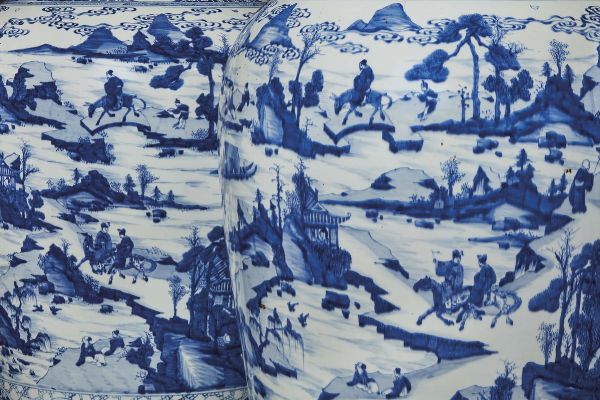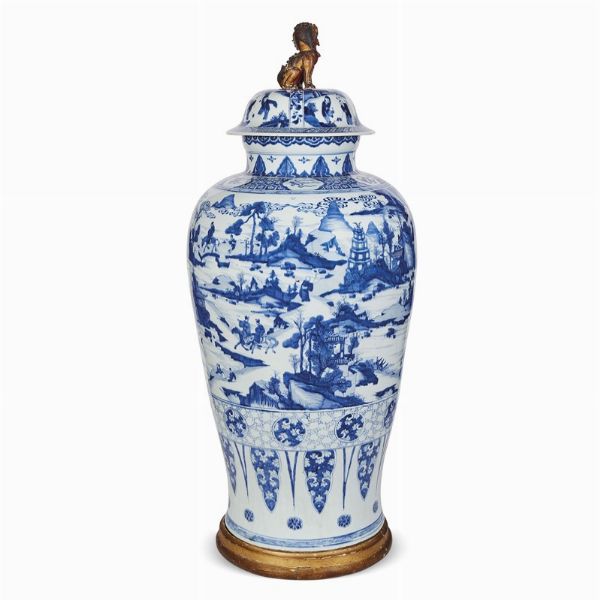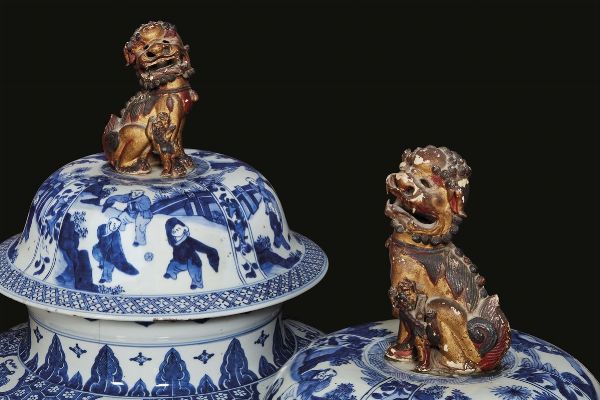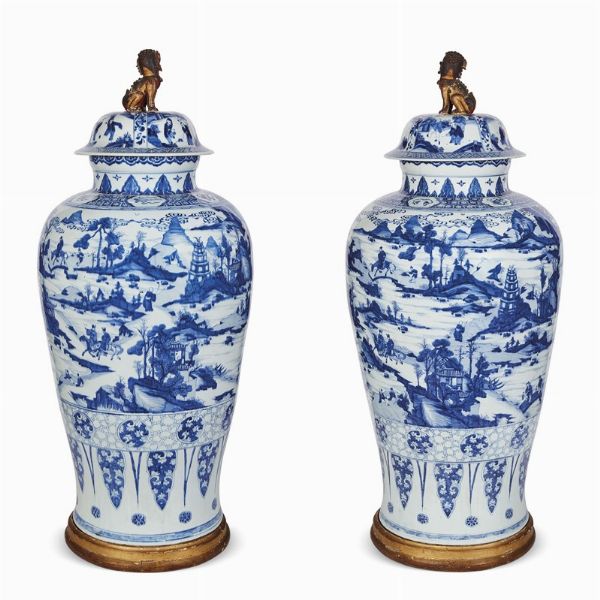

SHARE
23
COPPIA DI VASI, CINA, DINASTIA QING, SEC. XVII PERIODO KANGXI
COPPIA DI VASI, CINA, DINASTIA QING, SEC. XVII PERIODO KANGXI
in porcellana bianco blu a spalla alta con coperchio, decorato con paesaggio verticale.
Alt.cm 125
清 十七世纪 青花山水人物故事大尊一对 生瓷狮子盖
A PAIR OF VASES, CHINA, QING DYNASTY, 17TH CENTURY
LA VITA CINESE DIPINTA SU PORCELLANA
I vasi di periodo Kangxi (1662-1722) sono più singolari di altre produzioni simili, soprattutto per il tipo di rappresentazioni. Nei vasi appaiono una serie di topografie che fanno riferimento a luoghi di culto relativi a buddhismo, taoismo, confucianesimo. Gli edifici di questi luoghi sono molto diversi tra loro con riferimenti ad alcune architetture storiche legate alle scuole filosofiche di quei decenni, anche con commistioni di tipo sincretistico. Tali riferimenti cristallizzano una mappa geo-spirituale unica: la bottega che ha realizzato i vasi fornisce informazioni paesaggistiche riferibili a luoghi reali, cercando di riportarne le caratteristiche salienti. I personaggi sono filosofi, saggi, studiosi ritratti mentre viaggiano, ma anche intenti nelle proprie attività spirituali, pedagogiche, educative, intellettuali. Vi sono riferimenti anche a figure più umili al loro servizio, a cavalcature a dorso di cavallo e di mulo che descrivono l’appartenenza a ceti specifici con ruoli di carattere pubblico. È anche possibile che vi siano allusioni di carattere più leggendario/mitologico relative a Confucio stesso e ad alcuni discepoli più della cerchia più ristretta. L’unicità dei riferimenti topografici, geografici, storici, filosofici rende possibile ipotizzare che i vasi non fossero stati prodotti esclusivamente per il mercato occidentale, ma che fossero destinati allo stesso mercato cinese, possibilmente ad alti funzionari o a figure della corte imperiale, forse principi o nobili. Nel rinnovato spirito neoconfuciano, le rappresentazioni dei vasi testimoniano la necessità di sostenere il pluralismo di scuole orientate a integrare riferimenti di natura politico-spirituale attraverso un apparato iconografico che richiama all’unità culturale delle tre grandi tradizioni spirituali. Attraverso riferimenti incrociati riscontrabili in altri manufatti della cultura materiale del periodo, si potrebbero definire più in dettaglio i luoghi presenti, risultato che restituirebbe una rarissima mappa storica di topografie, architetture e geografie della Cina.
康熙时期(1662-1722)这对花瓶相较其他同时期作品更为独特,尤其是表现形式。 花瓶图纹呈现了一系列地形景观,涉及与佛教、道教、儒教相关的礼拜场所。这些地方的建筑各不相同,参 考了哲学流派或宗教相关的一些历史建筑,也有一些建筑风格同时兼具东西方建筑的特征。形成了一幅独特 的地理非物质文化地图。这些人物可能是哲学家、圣人、学者,专注于他们自己的精神、教学、教育和文化 活动。也有也有属于具有公共性质角色的特定阶级,拥有马和骡子等坐骑的旅人。也有可能有更多关于孔子 本人和一些弟子的传奇神话性质的典故。地形、地理、历史和哲学参考的独特性使我们可以假设这些花瓶并 不是专门为西方市场生产的,更是为中国市场本身准备的,可能是为朝廷人物准备的,也许是王公贵族。 在儒家精神中,花瓶的图纹所呈现的景观表现了当时支持学问的多元化,提倡百家争鸣的中华传统在当时中西方交流中得以彰显,让人想起三大精神传统的文化统一。通过在那个时期物质文化遗产中发现的跨文化特 征,这对花瓶呈现的是一幅非常罕见的其时代地形、建筑和历史地理图景。
This pair of vases in Kangxi period (1662-1722) is more unique than other works of the period, especially in the form of expression. The vase presents a series of landscapes, involving places of worship related to Buddhism, Taoism, and Confucianism. The buildings in these places are different, referring to some historical buildings related to philosophical schools or religions, and some architectural styles have the characteristics both of eastern and western. Formed a unique geographical intangible cultural map. These figures may be philosophers, saints and scholars, focusing on their spiritual, teaching, educational and cultural activities. There are also specific classes with public roles, travelers with horses, mules and other mounts. It is also possible to have more legendary, mythical stories about of the Confucius and his disciples. The uniqueness of terrain, geography, history, and philosophy makes us to assume that the vases are not produced for the western market specially, but also for the China market, possibly for court figures and perhaps nobles. Like in the spirit of neoconfucianism, the landscape presented by the vase patterns showed the Chinese tradition of supporting the diversification of learning and advocating a hundred schools of thought at that time, which was highlighted in the communication between China and the West at that time, and it was reminiscent of the cultural unity of the three spiritual traditions. Through the cross-cultural features found in the material cultural heritage of that period, this pair of vases presents a very rare map that conforms to the topography, This pair of vases presents a very rare landscape of its time, topography, architecture and historical geography.
in porcellana bianco blu a spalla alta con coperchio, decorato con paesaggio verticale.
Alt.cm 125
清 十七世纪 青花山水人物故事大尊一对 生瓷狮子盖
A PAIR OF VASES, CHINA, QING DYNASTY, 17TH CENTURY
LA VITA CINESE DIPINTA SU PORCELLANA
I vasi di periodo Kangxi (1662-1722) sono più singolari di altre produzioni simili, soprattutto per il tipo di rappresentazioni. Nei vasi appaiono una serie di topografie che fanno riferimento a luoghi di culto relativi a buddhismo, taoismo, confucianesimo. Gli edifici di questi luoghi sono molto diversi tra loro con riferimenti ad alcune architetture storiche legate alle scuole filosofiche di quei decenni, anche con commistioni di tipo sincretistico. Tali riferimenti cristallizzano una mappa geo-spirituale unica: la bottega che ha realizzato i vasi fornisce informazioni paesaggistiche riferibili a luoghi reali, cercando di riportarne le caratteristiche salienti. I personaggi sono filosofi, saggi, studiosi ritratti mentre viaggiano, ma anche intenti nelle proprie attività spirituali, pedagogiche, educative, intellettuali. Vi sono riferimenti anche a figure più umili al loro servizio, a cavalcature a dorso di cavallo e di mulo che descrivono l’appartenenza a ceti specifici con ruoli di carattere pubblico. È anche possibile che vi siano allusioni di carattere più leggendario/mitologico relative a Confucio stesso e ad alcuni discepoli più della cerchia più ristretta. L’unicità dei riferimenti topografici, geografici, storici, filosofici rende possibile ipotizzare che i vasi non fossero stati prodotti esclusivamente per il mercato occidentale, ma che fossero destinati allo stesso mercato cinese, possibilmente ad alti funzionari o a figure della corte imperiale, forse principi o nobili. Nel rinnovato spirito neoconfuciano, le rappresentazioni dei vasi testimoniano la necessità di sostenere il pluralismo di scuole orientate a integrare riferimenti di natura politico-spirituale attraverso un apparato iconografico che richiama all’unità culturale delle tre grandi tradizioni spirituali. Attraverso riferimenti incrociati riscontrabili in altri manufatti della cultura materiale del periodo, si potrebbero definire più in dettaglio i luoghi presenti, risultato che restituirebbe una rarissima mappa storica di topografie, architetture e geografie della Cina.
康熙时期(1662-1722)这对花瓶相较其他同时期作品更为独特,尤其是表现形式。 花瓶图纹呈现了一系列地形景观,涉及与佛教、道教、儒教相关的礼拜场所。这些地方的建筑各不相同,参 考了哲学流派或宗教相关的一些历史建筑,也有一些建筑风格同时兼具东西方建筑的特征。形成了一幅独特 的地理非物质文化地图。这些人物可能是哲学家、圣人、学者,专注于他们自己的精神、教学、教育和文化 活动。也有也有属于具有公共性质角色的特定阶级,拥有马和骡子等坐骑的旅人。也有可能有更多关于孔子 本人和一些弟子的传奇神话性质的典故。地形、地理、历史和哲学参考的独特性使我们可以假设这些花瓶并 不是专门为西方市场生产的,更是为中国市场本身准备的,可能是为朝廷人物准备的,也许是王公贵族。 在儒家精神中,花瓶的图纹所呈现的景观表现了当时支持学问的多元化,提倡百家争鸣的中华传统在当时中西方交流中得以彰显,让人想起三大精神传统的文化统一。通过在那个时期物质文化遗产中发现的跨文化特 征,这对花瓶呈现的是一幅非常罕见的其时代地形、建筑和历史地理图景。
This pair of vases in Kangxi period (1662-1722) is more unique than other works of the period, especially in the form of expression. The vase presents a series of landscapes, involving places of worship related to Buddhism, Taoism, and Confucianism. The buildings in these places are different, referring to some historical buildings related to philosophical schools or religions, and some architectural styles have the characteristics both of eastern and western. Formed a unique geographical intangible cultural map. These figures may be philosophers, saints and scholars, focusing on their spiritual, teaching, educational and cultural activities. There are also specific classes with public roles, travelers with horses, mules and other mounts. It is also possible to have more legendary, mythical stories about of the Confucius and his disciples. The uniqueness of terrain, geography, history, and philosophy makes us to assume that the vases are not produced for the western market specially, but also for the China market, possibly for court figures and perhaps nobles. Like in the spirit of neoconfucianism, the landscape presented by the vase patterns showed the Chinese tradition of supporting the diversification of learning and advocating a hundred schools of thought at that time, which was highlighted in the communication between China and the West at that time, and it was reminiscent of the cultural unity of the three spiritual traditions. Through the cross-cultural features found in the material cultural heritage of that period, this pair of vases presents a very rare map that conforms to the topography, This pair of vases presents a very rare landscape of its time, topography, architecture and historical geography.
Arte Orientale | 东方艺术
mar 20 DICEMBRE 2022



